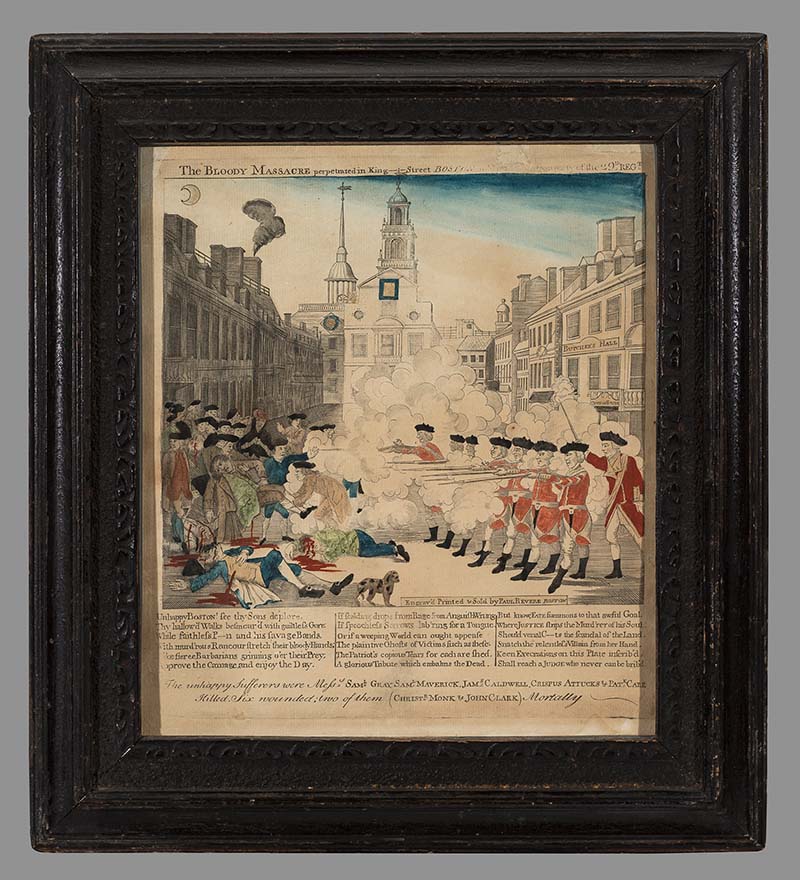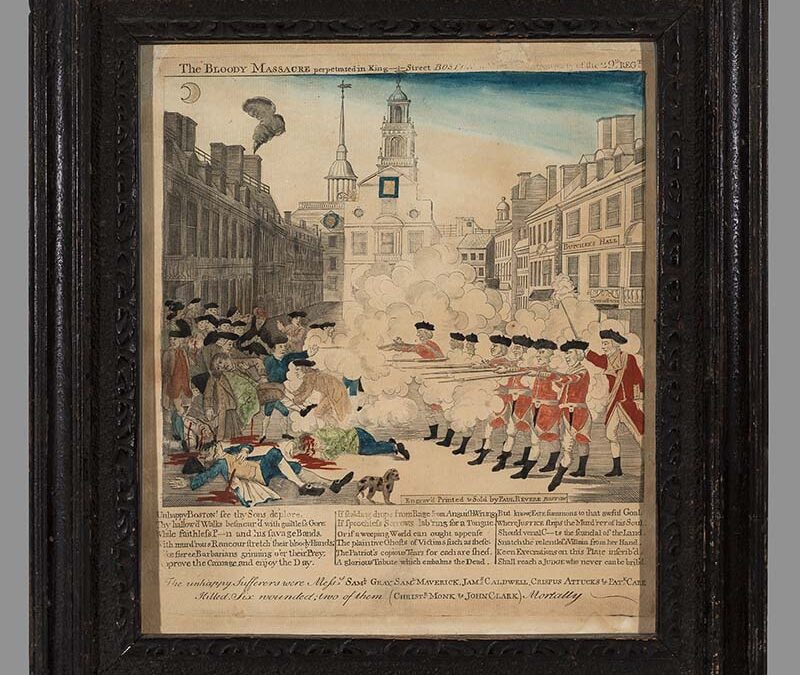The BLOODY MASSACRE perpetrated in King--I--Street BOSTON on March 5th 1770 by a party of the 29th REGT

| Maker | Paul Revere, Jr. (1734–1818, Engraver, printer, and seller), Christian Remick (Colorist) |
| Date of Creation | 1770 |
| Location | Boston, Massachusetts |
| Materials | Line engraving, etching, and polychrome watercolors on laid paper |
| Institution | Winterthur Museum, Garden & Library |
| Credit Line | Bequest of Henry Francis du Pont |
| Accession Number | 1955.0500 |
| Photo Credit | Winterthur Museum, Garden & Library |
This hand-colored engraving, produced by silversmith and engraver Paul Revere, depicts the violent aftermath of skirmish in Boston on March 5, 1770, an event now known as the Boston Massacre. An important milestone in American print culture, this image underscores the city’s reputation as the center of early American publishing and highlights its role as a major site for the production of pro-Revolution propaganda. Revere’s exaggerated portrayal of a multi-racial, working-class coalition animated narratives of populist concerns driving the movement for American independence.
A few weeks before the massacre, on February 22, 1770, a British customs officer fatally shot 11-year-old Christopher Seider. The gun firing from the window of the building on the right of Revere’s print, labeled “Customs House” and, perhaps sarcastically, “Butcher’s Hall,” may have alluded to Seider’s death. Samuel Adams arranged a public funeral for the boy, fueling outrage against British troops and increasing tension in the community, resulting in the events of March 5. On that day, a group of artisans and laborers hurled insults and projectiles in a confrontation with British soldiers. Revere’s sensationalized take depicts a row of troops shooting into the crowd, commanded by Captain Preston on the right with his sword raised. The decision to fire left five dead, two mortally wounded, and four injured. Those killed included: Crispus Attucks, a whaler and sailor; Patrick Carr, employed by a breeches maker; Samuel Maverick, apprenticed to an ivory turner; James Caldwell, an apprentice mariner; and Samuel Gray, a ropemaker. Revere’s caption further records Christopher Monk, a shipwright’s apprentice, and John Clark, an apprentice to a ship’s captain, as mortally wounded (New Hampshire Gazette and Historical Chronicle, March 16, 1770). Written in rhyming verse, the text documents his sensational approach, describing “hallowed walks besmeared by guiltless gore” and soldiers “grinning o’er their prey” in an appeal to the public’s growing resentment of the British colonial government.
After the Revolution, commemoration and collective memory of the massacre diminished, resulting in the gradual erasure of the racial and class identities of the men involved. Leading up to the Civil War, however, black scholars and intellectuals working for emancipation recentered one of the dead, Crispus Attucks, to argue for black freedom and citizenship. Alhough little is known for certain about Attucks, newspaper accounts describe him as a mixed-race man, born in Framingham, MA, and headed to North Carolina. He was likely descended from both Indigenous Americans and enslaved Africans who were forcibly brought to Massachusetts to work in the colony’s bustling ports and wealthy white merchants’ homes. Attucks himself may have been formerly enslaved, emancipating himself from William Brown in 1750. Nineteenth-century prints inspired by Revere’s work foregrounded Attucks to emphasize the patriotic contributions of black Americans to the nation’s history, creating an especially potent symbol of resistance to unjust authority decades after his death. Despite the use of Attucks’s death to support the cause of independence, John Adams, serving as defense attorney for the British soldiers on trial for murder, referred to him pejoratively, asserting that the carnage resulted directly from Attucks’ “mad behaviour” and labeling the colonists a “motley rabble of saucy boys” (Journal of the Early Republic, Vol. 29, No. 2).
In tension with Adams’s description, Revere’s exaggerated portrayal of a multi-racial, working-class coalition opposing British rule animated populist narratives as the impetus for American independence. Along with other advocates of revolution, Revere quickly seized on this violent event as a powerful tool to galvanize public support for the cause. Henry Pelham, John Singleton Copley’s half-brother, began a copperplate engraving of the scene, sharing it with Revere, who instantly recognized the commercial and political potential of the image. Published under his own name, Revere’s copy beat Pelham’s engraving to the market, going on sale within three weeks of the massacre, astonishingly quick for 1770. This image underscores Boston’s reputation as the center of early American publishing and highlights the city’s role as a major site for the production of pro-Revolution propaganda, representing an important milestone in American print culture.
The unique history of the Massachusetts colony and its capital propelled print to the forefront of American artistic tradition. Prints ameliorated the perceived lack of a fine-art painting tradition in British North America, where Puritans’ outsize influence on New England’s visual culture discouraged using art for aesthetic or sensual pleasure. As a result, prints became public and commercial documents, intended to educate, inform, instill religious values, and, in this instance, persuade. Copley’s 1768 portrait of Paul Revere at the Museum of Fine Arts Boston underlines the importance of engraving in early America, depicting the silversmith alongside his engraving tools. It would not have been unusual for Revere to copy fashionable, scrolling rococo designs on his silver. For him, plagiarism of an engraved copper printing plate may have represented only a lucrative opportunity, rather than a moral quandary about authorship. Perhaps ironically, demand for the print proved so great that Jonathan Mulliken, a Newburyport, MA, engraver, sold his own copies of Revere’s print, including an example at Winterthur (1955.0501).

